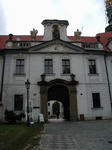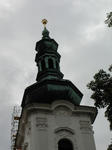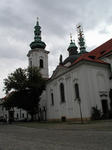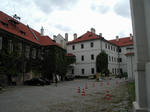 A very important architectural monument in Bohemia is the ancient monastery at Strahov. Covered by thick woods and brush, the hill above the Prague Valley was of no use to anything but wild animals for a long time. In the twelfth century monks cleared the hill and built a monastery made of wood. The monastery was commissioned by King Vladislav I of Bohemia in 1140.
A very important architectural monument in Bohemia is the ancient monastery at Strahov. Covered by thick woods and brush, the hill above the Prague Valley was of no use to anything but wild animals for a long time. In the twelfth century monks cleared the hill and built a monastery made of wood. The monastery was commissioned by King Vladislav I of Bohemia in 1140.
It was built on the highest point on the approach route to Prague Castle. Due to the need of an armed guard to protect the pilgrims and travellers going to the castle, this was an ideal place. When the building was completed it came to be known as the Venue of Diets. Foreign delegates and other important political figures were housed there on their way to Prague Castle. In 1258, a fire ravaged the building, and it was completely destroyed.
Rebuilding soon began. "The Town Chronicle of Petr of Eerchov", tells of the structure and surrounding gardens, vineyards, and grounds of the monastery. It was named, Strahov, because of the Czech word,"strahovat", which means to guard. Strahov became a monastery when the Bishop of Olomouc, Jindrich Zdik, founded an order of Premonstrates there. The Bishop had become acquainted with the order on his pilgrimage to Palestine. The Bishop found their reforming ways perfect for giving the soon to be monarch Sobislav I a polished, prestigious, and powerful cultural background. The monastery became a center of learning with a library and a school, where all of the influential people of the country were educated. The magnificent structures erected show to this day that the building was of great importance. The structures also reflect the rising power of the Poemyslid princes. Who, at that time, were trying to make Prague Castle a respected residence for the monarch.
Shortly after the construction of the monastery was completed, a great threat emerged. Emperor Josef II came into power. He was not a man of religion or culture; he was a soldier without interest in anything that gave no profit to the public.
The only thing that saved the monastery was the brainstorm of Abbot Mayer, a member of the Masonic lodge at the Three Crown Columns. He proposed to erect a public library next to the already existing library in the next to the already existing library in the monastery. Jesef II accepted, and the Strahov Monastery stayed open.
During the Renaissance, a grand reconstruction was undertaken after George of Podibrady ascended the throne. Many new buildings and other surrounding structures were added to the already impressive monastery. The monastery flourished under Abbots Jan Lohel, Kaspar of Quetenberg and Crispin Fuk, who continuously added structures to the monastery. They all took advantage of the flourishing economical and political conditions before the defeat of the Bohemian Estates.
Today, the monastery is of great importance in the history of the Czech Republic. In 1989 its archives housed over 6 million items. The Strahov library contains over 900 thousand volumes and 300 thousand works of expressive art. The oldest manuscript is a summary of the Gospels which dates back to the tenth century. The collection is extremely valuable not only in monetary figures but in historical significance as well. The collection includes works of world famous printers such as Aldus Pius Manutius of Venice, Frobenius of Basle, Plantin from Antwerp, and the famous publisher Elsevier. Also included are typographs dating back to the eighteenth century from the renowned Italian, Bodoni.
Another important work of art is a ceiling fresco in the monastery painted
by Anton Maulbertsh. The fresco symbolizes the human search for truth through religious wisdom. The painting includes a picture of French encyclopedists hovering above an abyss between spiders and toads, terrified by the power of religious wisdom over science. However a strange irony exists here. In the same hall as the fresco, the monks placed the encyclopedia in a place of honor as its first literary work.
The Picture Gallery of the Premonstratensian Abbey at Strahov was founded by the Abbot Hieronymus Joseph Zeidler in 1836. Before this the immense collection of art in possession of the monastery was either displayed throughout, or stored due to lack of space. During this period the collection was categorized, and the gallery was improved with the addition of new paintings acquired by the monastery. The picture gallery remained in this form until the 1950's when communists abolished the Abbey.
The library and gallery were changed to the Museum of National Literature; however, they were given back to the monks in 1990 after the fall of communism. The collection was completely restored in 1992 when a permanent exhibition was opened. The exhibit shows 99 of the highest quality paintings and sculptures the monastery possesses.
The Strahov Monastery Gallery contains many of the most important works of art created during the Bohemian and Central European Gothic and Renaissance periods. This collection include the panel paintings of the Strahov Madonna from around 1340, St. Barbara painted in 1410, the Death of the Virgin Mary by a Salzburg master from the end of the fifteenth century, the Strahov Altarpiece by the Master of the Litomiocie Altarpiece made in 1510, the Doksany Altarpiece, and Judith by Monogrammist IW, a gifted disciple of Lucas Cranach the Elder, from the 1520's. It also contains sets of paintings by Rudophinian mannerists B. Spranger, J. Heintz the Elder, and D. de Quade van Ravesteyn. Also included are paintings by Bohemian and Central European Baroque painters such as J. J. Hering, K. Skreta, A. Stevens of Steinfels, J. J. Heinsh, M. V. Halbax, P. Brandl, and V. V. Reiner. Some Rococo painters accommodated by the gallery are N. Grund, F. K. Palko, A. Kern, M. J. Schmidt, and A. Maulbertsch. Dutch, Flemish, and Italian paintings of the 17th and 18th century are also well represented by some outstanding pictures. The permanent exhibition ends with paintings by distinguished Bohemian masters of the end of the 18th and first half of the 19th centuries. The last painting in the exhibit is a copy of The Rosary Feast by Albrecht Durer, which was created on the occasion of its restoration in 1840-1841. The Rosary Feast was originally bought by the Strahov Monastery in 1793. It remained the strong point of the gallery until 1934. It was then moved to the National Gallery in Prague. Paintings and sculptures are not all the gallery has to offer though. It contains a very respectable collection of arts-and-crafts objects, the center point being two excellent reliquaries from the beginning of the 14th century. They represent the exquisite beauty of high Gothic jewelry.
The Stahov Monastery has a long and illustrious past that has a very important role in Bohemian history. It is an important and very large tourist attraction. The National Museum is still housed there, but only for a limited time. The collections acquired by the museum will be moved to other establishments as they become available. The Strahov Monastery is a fine example of the important role religion has played on the lives of central Europeans for centuries. It is a wonderful example of the architecture of the Gothic and Renaissance periods, and will always stand as a monument to the past.
 Průvodce
Průvodce 




